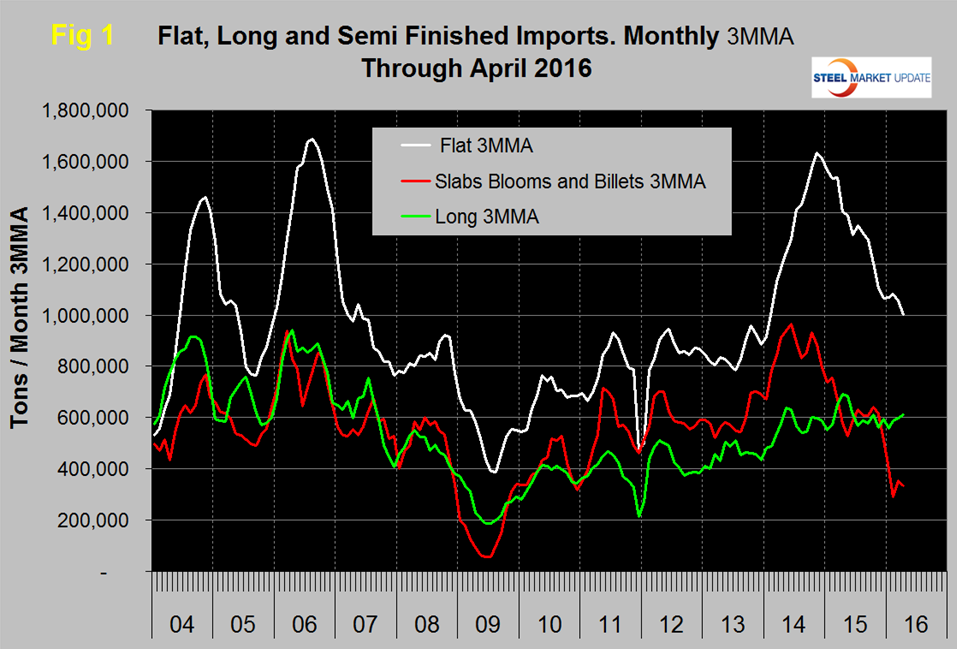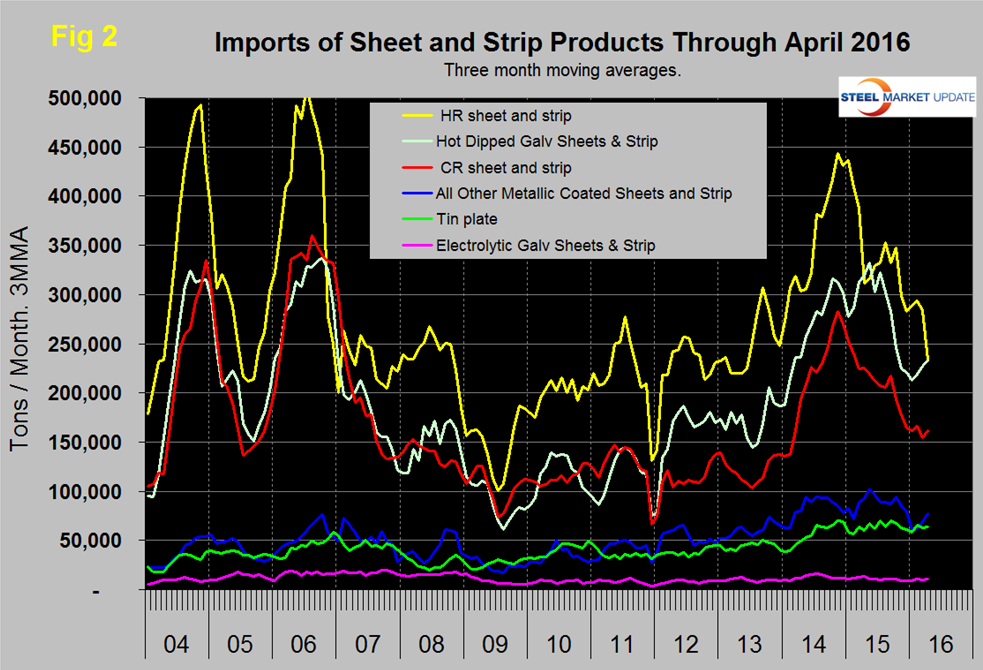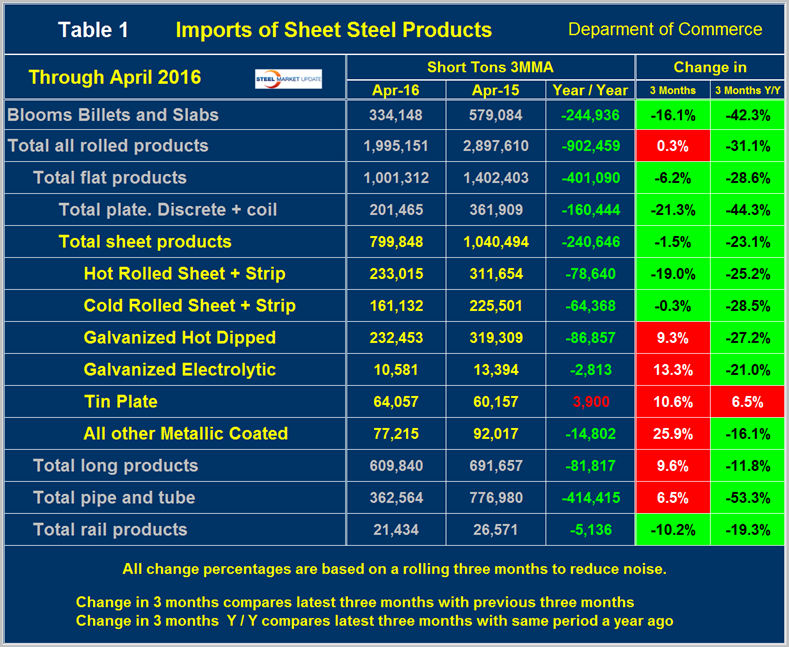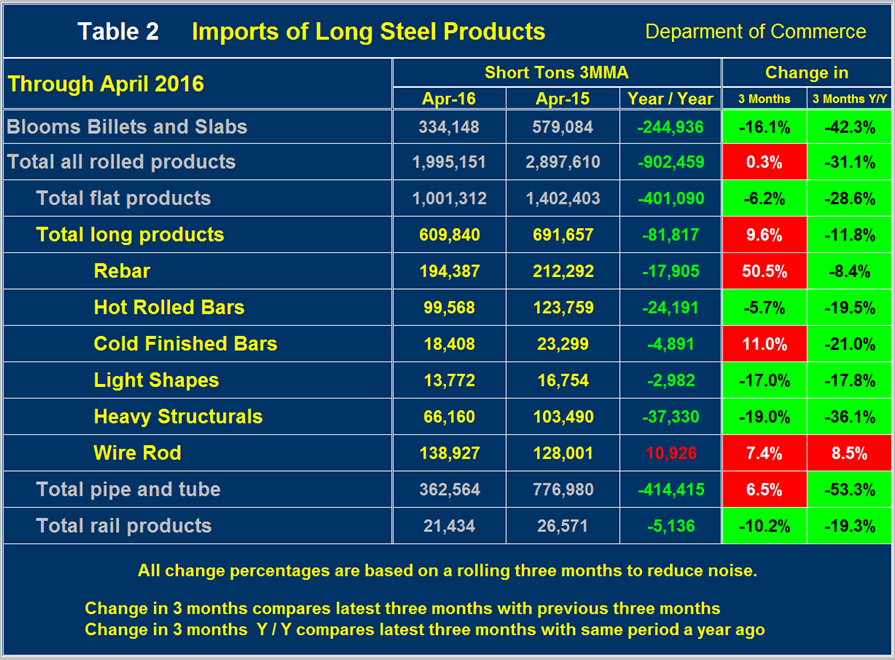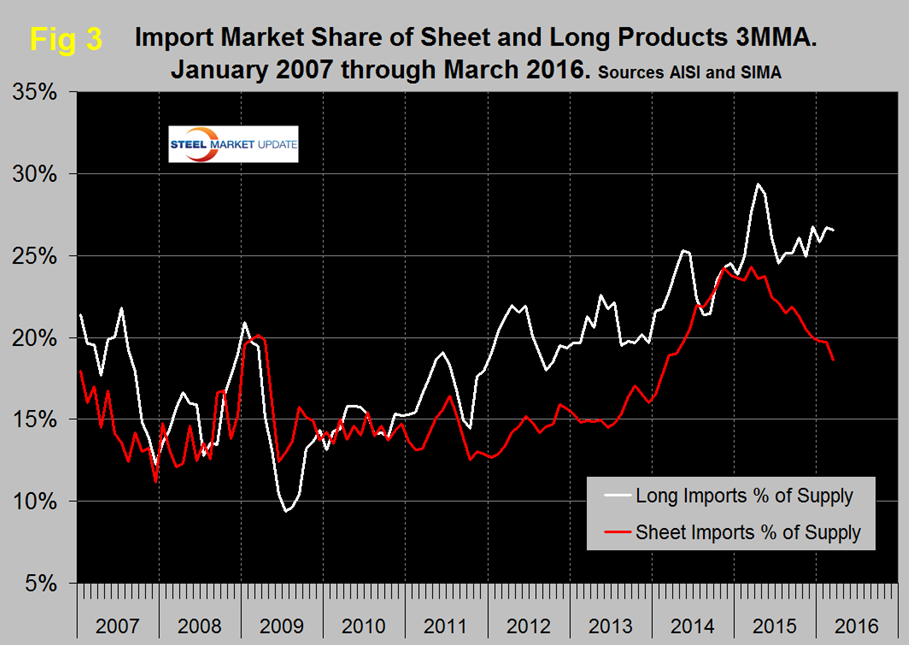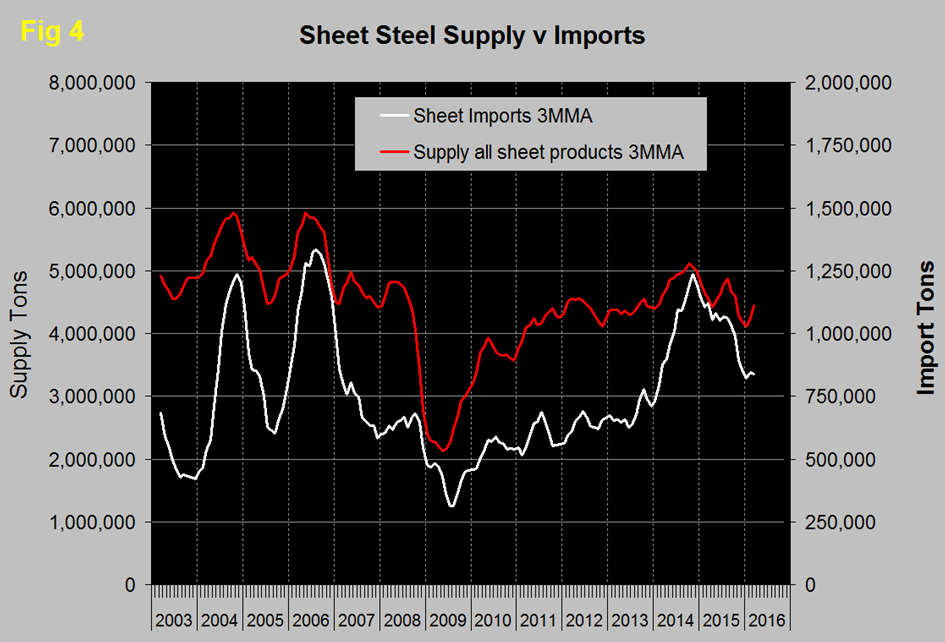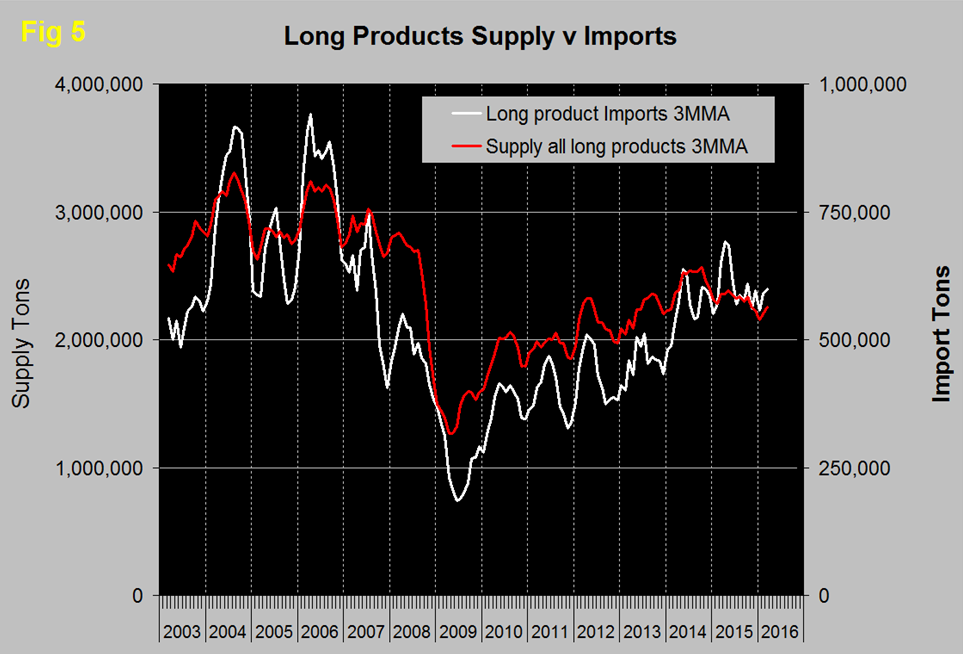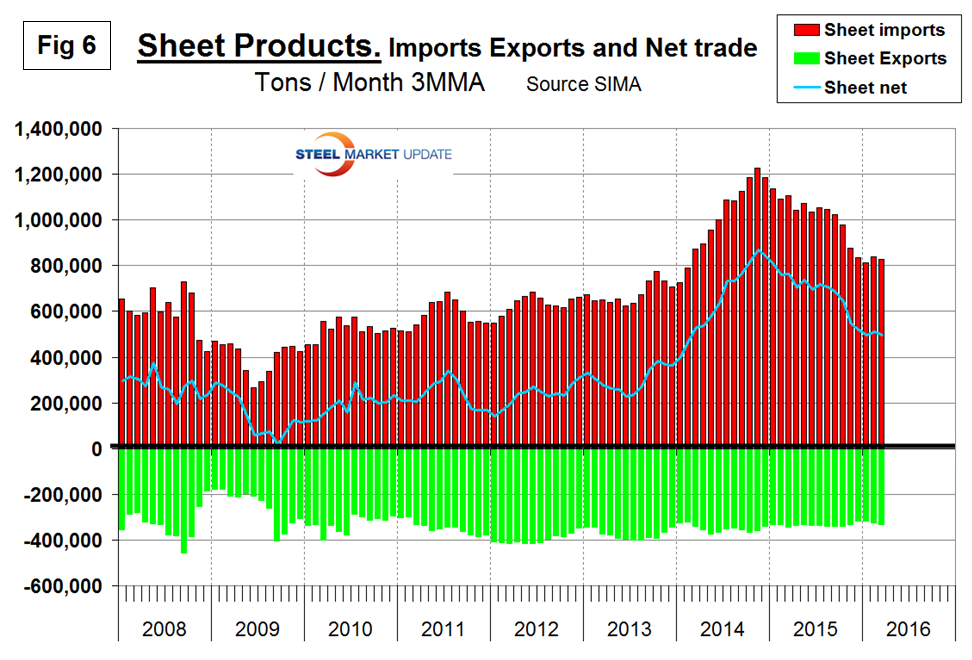Steel Products Prices North America

Flat, Long, and Semi-Finished Imports through April 2016
Written by Peter Wright
May 6, 2016
Licensed data for April was reported by the Steel Import Monitoring System of the US Commerce Department on May 3rd. An explanation of the methodology that we at SMU use to analyze the trade data is given at the end of this piece.
![]() Total rolled product licensed imports in the single month of April were 1,969,561 short tons which was almost exactly the same as the final March tonnage. Imports of semi-finished declined from 486,697 in March to 348,321 tons in April. We prefer not to dwell on single months results because of the extreme variability that can occur in individual products. In the comments below we use only three month moving averages (3MMA) to get a more representative picture. The 3MMA of semi-finished through April was 334,148 tons, down by 5.8 percent from March. On this basis the volume of all rolled products was down by 2.8 percent, flat rolled was down by 5.1 percent of which sheet products were down by 3.4 percent. Long products were up by 1.9 percent and pipe and tube down by 2.1 percent.
Total rolled product licensed imports in the single month of April were 1,969,561 short tons which was almost exactly the same as the final March tonnage. Imports of semi-finished declined from 486,697 in March to 348,321 tons in April. We prefer not to dwell on single months results because of the extreme variability that can occur in individual products. In the comments below we use only three month moving averages (3MMA) to get a more representative picture. The 3MMA of semi-finished through April was 334,148 tons, down by 5.8 percent from March. On this basis the volume of all rolled products was down by 2.8 percent, flat rolled was down by 5.1 percent of which sheet products were down by 3.4 percent. Long products were up by 1.9 percent and pipe and tube down by 2.1 percent.
Figure 1 shows the 3MMA through April licenses for semi-finished, flat and long products.
Flat includes all hot and cold rolled sheet and strip plus all coated sheet products plus both discrete and coiled plate. The 3MMA of flat rolled imports peaked at 1,634,000 tons in November 2014 and at 1,078,045 tons in April 2016 has been < 1.1 million tons for five consecutive months. Long product imports have been range bound between 519,000 tons and 772,000 tons since March 2014 with no particular trend evident. In April the 3MMA of long product imports was 609,840 tons.
Figure 2 shows the trend of sheet and strip products since January 2004.
Hot rolled continued its rapid decline in April as HDG and other metallic coated (mainly Galvalume) increased. Cold rolled had a small upward blip in its long term declining trend. Tin plate and electro galvanized were little changed in April.
Table 1 provides an analysis of major product groups and of sheet products in detail. It compares the average monthly tonnage in the latest three months through April with both three months through January (3M/3M) and three months through April 2015 (Y/Y).
On a Y/Y basis the total of all rolled products was down by 31.1 percent, as total sheet products were down by 23.1 percent. Tubulars were down by 53.3 percent. Semi-finished slabs, blooms and billets were down by 42.3 percent and long products were down by 11.8 percent. Tin plate was the only sheet product to have a Y/Y increase. There was an increase in many categories on a 3M/3M basis as indicated by the color code red. Hot rolled and cold rolled were down but all other sheet products increased. The total volume of hot worked products was up by 0.3 percent 3M/3M but down by over 900,000 tons Y/Y. These trends indicate that in the big picture and with the exception of long products the overall volume of imports is falling fast. The color codes in Tables 1 and 2 for the three month and year over year change show which products are improving and which have still experienced import volume increases in these two time frames.
Table 2 shows the same analysis for long products.
The total tonnage of long products was down by almost 82,000 tons per month Y/Y. Wire rod was the only product to have a volume increase on this basis.
Figure 3 shows the import market share of sheet and long products through March which is the latest data available for total steel supply.
The import market share of sheet products peaked at 24.3 percent in March 2015 and has been <20 percent for each month of 2016 through March. Long product import market share peaked at 29.4 in April 2015 but has only had two months since then below 25 percent. Figure 4 and Figure 5 show supply and imports for sheet and long products respectively on double axis graphs.
Note that the scales are proportional and start at zero in all cases so there is no data manipulation. Our point is to expand on the theme that the situation of sheet and long products is completely different. The import surges of 2004 and 2006 were clearly driven by demand for both product groups. The late 2014 surge in sheet product imports was not driven by a proportional increase in domestic demand and have dropped off much faster than the demand decline. We interpret this to be a manifestation of global over supply followed by buyer caution as trade case activity increased. In the case of long products, imports and demand have had an 89.9 percent correlation since January 2009. This indicates that almost all of the changes in import volume can be explained by factors in the domestic market and that import market share in the immediate future will not follow the lead of sheet products.
Net imports equals imports minus exports and our analysis is based on the final volumes through March. We regard this as an important look at the overall trade picture and its effect on demand at the mill level. Figure 6 shows that net sheet product imports on a 3MMA basis at 495,935 tons in March were down by 268,000 tons year over year.
Compared to imports, exports have been relatively consistent for almost eight years. Net sheet steel imports are still strong by historical standards. The recent decline in the value of the US$ will have a down-ward influence on this aspect of total steel trade.
Explanation: The SMU publishes several import reports ranging from this very early look using licensed data to the very detailed analysis of final volumes by product, by district of entry and by source nation which is available on the premium member section of our web site. The early look, the latest of which you are reading now has been based on three month moving averages (3MMA) using the latest licensed data, either the preliminary or final data for the previous month and final data for earlier months. We recognize that the license data is subject to revisions but believe that by combining it with earlier months in this way gives a reasonably accurate assessment of volume trends by product as early as possible. We are more interested in direction than we are in absolute volumes at this stage. The main issue with the license data is that the month in which the tonnage arrives is often not the same month in which the license was recorded. In 2014 as a whole our data showed that the reported licensed tonnage of all carbon and low alloy products was 2.3 percent less than actually receipts, close enough we believe to confidently include licensed data in this current update. The discrepancy declined continuously during the course of the twelve month evaluation as a longer time period was considered.

Peter Wright
Read more from Peter WrightLatest in Steel Products Prices North America

SMU Price Ranges: Sheet and plate steady ahead of Independence Day
Sheet and plate prices were little changed in the shortened week ahead of Independence Day, according to SMU’s latest check of the market.

Nucor maintains plate prices, opens August order book
Nucor aims to keep plate prices flat again with the opening of its August order book.

Nucor CSP remains level at $900/ton
Nucor maintained its weekly list price for hot-rolled (HR) coil this week, following two consecutive increases.

Cliffs raises prices, seeks $950/ton for July spot HR
Cleveland-Cliffs plans to increase prices for hot-rolled (HR) coil to $950 per short ton (st) with the opening of its July spot order book. The Cleveland-based steelmaker said the price hike was effective immediately in a letter to customers dated Monday.

HRC vs. prime scrap spread widens in June
The price spread between HRC and prime scrap widened in June.

